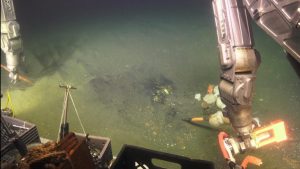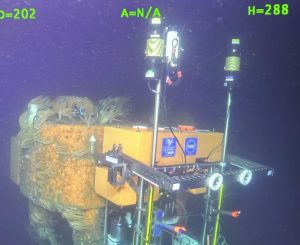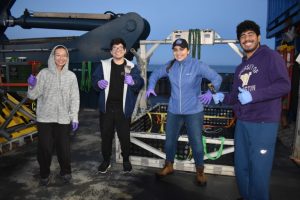The R/V Atlantis has been non-stop with activity over the last four days!
The log trapping the cables at the 80 m shelf site was dealt with by Jason carefully grasping either end and “flossing” the cable out from under the log until it was freed. This allowed all the instruments and packages at the site to be successfully swapped, including a benthic experiment package (BEP), a zooplankton sonar, and a digital still camera.
We have also completed all the equipment swaps at Oregon Offshore, although operations there took a little longer than expected. A cable connecting the BEP to the junction box had shorted and had to be recovered. The team is well prepared for almost anything that the ocean and our equipment can throw at us, so we already had a spare cable onboard and were able to deploy it instead. Similarly, the profiling pod on the 200 m shallow profiler mooring that was deployed on Leg 1 had a faulty sensor. Again, we had a spare onboard and were able to recover the profiling pod, swap the sensor, and get it back in place. While both dives and the instrument swap only took 5 hours, finding the right five hours to do them in was tricky. Currents at the Oregon Offshore site have increased significantly since we were last there on Leg 1 and, while they weren’t noticeable while working on the seafloor, at 200 m they tugged and pulled on Jason so much that it was impossible for the ROV pilots to tackle the delicate operations necessary to unlock and latch into the profiling package the first time we dove there. We suspect that the increased currents may have something to the full moon we’ve had this week and tried to time our second attempt at a different point in the tidal cycle. On that second dive, while the currents were still very strong, we were able to recover the package, swap the instrument, and re-deploy the profiling pod.
The most recent site we have been working at is Southern Hydrate Ridge. This site is a methane seep where solid methane ice (aka “gas hydrate”) lies just below the seafloor. When the methane escapes from within or below the ice it bubbles to the surface, fueling a rich chemosynthetic community. At the site we swapped a digital still camera as well as three uncabled osmotic fluid samplers. This year we saw a lot of change on the seafloor – increased bacterial mat growth, more large hummocks and depressions, and even some exposed hydrate where it hadn’t previously been observed. In addition to the normal RCA work we do at the site, Dr. Laura Lapham and her grad student Anna Hildebrand joined us for Leg 2 to recover four osmotic fluid samplers deployed last year as well as sample push cores (to collect sediment), biology, carbonate rocks, and Niskins for water.
The VISIONS’24 students have been closely involved in all of these operations. Not only do they log and take photos in the ROV control van (their “normal” shift work), they have also jumped in to help clean the instruments and equipment recovered from the seafloor. Much of the equipment at the coastal sites becomes a home to marine animals, especially anemones and barnacles. The students have also been helping Laura and Anna with processing the osmosamplers, water samples, and especially the many push cores they have brought back. It hasn’t been all work for the students though they have also gotten to see whales, heard from onboard scientists and engineers during formal and informal chats, and taken a tour of the Atlantis engine room.

Jason attempts to dislodge a log covering cables at the Oregon Shelf site. Credit: UW/NSF/OOI/WHOI; J2-1624; V24.

Main float PIA and SPA units. Credit: Leo Couchon, University of Washington; V24.

VISIONS’24 students after Cleaning MJ01C: M. Elend, University of Washington; V24.
Recent Updates